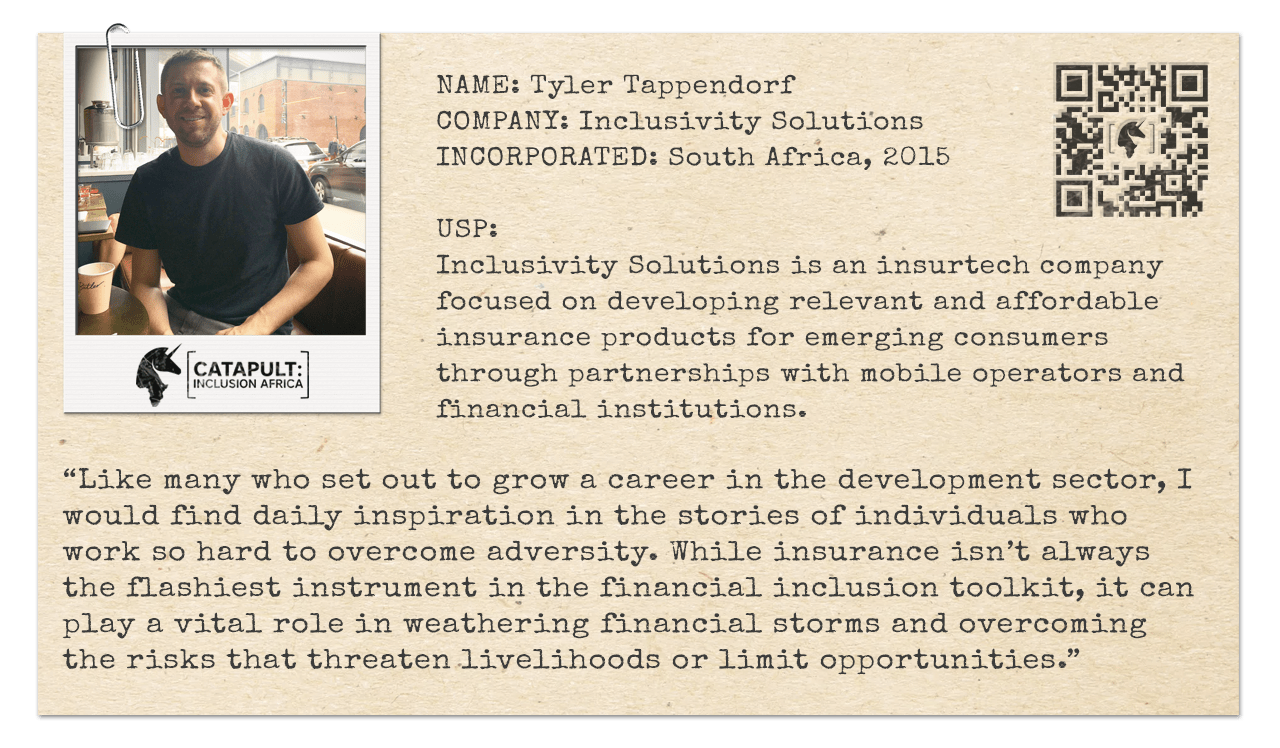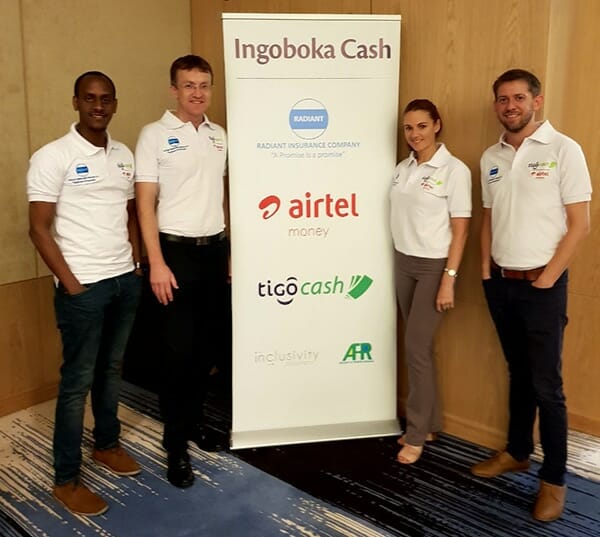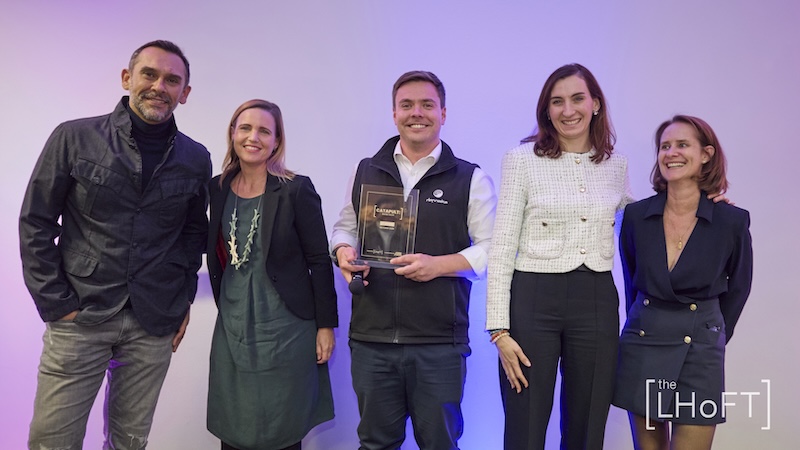At the LHoFT, we strongly believe that financial technology is crucial to advancing financial inclusion, empowering groups that have been left behind by the traditional financial system. Whether it’s financing for rural farmers, point of sale technology for underbanked merchants, or specialised insurance products, the positive impact being driven by entrepreneurship is improving lives around the world.
Building on the success of previous experience, CATAPULT: Inclusion Africa is a unique one week program of Fintech startup development built by the LHoFT Foundation, targeting African Fintech companies, focusing on creating bridges between Africa and Europe and aligned with the sustainability goals of Luxembourg’s finance centre.
In the run up to our Financial Inclusion event we will be sharing insight from key figures in the Financial Inclusion world, beginning with Tyler Tappendorf, Co-Founder of Inclusivity Solutions
“With so many exciting technologies to leverage for innovation, it’s very easy to craft flashy new products and apps that look cool but miss the mark in terms of customer needs.”

Can you tell us a little about yourself and your company?
Inclusivity Solutions is an African-based insurtech company that’s committed to getting affordable and relevant insurance products to emerging consumers. While most of our team is based at our head office in South Africa, we have staff across the continent and active initiatives currently in Kenya, Rwanda, and Ivory Coast. Working with partners, we provide the technology through which insurance can be accessed even through the most basic mobile phones. It’s been a fun first few years growing and learning. As of October 2018, we’ve signed up over 400,000 customers and paid out over 1,000 claims – nearly all to customers who previously had little or no experience with insurance. We really have a double-bottom-line focus, where we aim for sustainability through profitability, while ensuring our products provide high customer value and a positive social impact on the communities we target.
Inclusivity Solutions has been a great opportunity for me to bring together two different paths I’ve taken. After graduating from university with an actuarial degree, I decided I instead wanted to focus more on the development sector. I spent time working with community-based NGOs over the next few years, and eventually got involved with Fonkoze, Haiti’s largest microfinance organization. It was kind of by fate that, during my time with Fonkoze, I had the chance to manage a new microinsurance initiative helping small market sellers protect themselves from natural disasters. From there, I saw how insurance can play such a vital role in development. And the rest is history.

Inclusivity Solutions team at our product launch event with Airtel-Tigo in Rwanda
What were you involved in before Inclusivity Solutions which led to the development of this idea?
Prior to helping establish Inclusivity Solutions, I was working for a financial inclusion consulting firm based in Cape Town. A number of my projects were related to microinsurance—and specifically insurance products that were beginning to leverage mobile phones for distribution. I worked with a couple of the big mobile operators in southern Africa, evaluating opportunities for how they could launch insurance and health-related products. Finally, after a few years and thanks to the vision and drive of Jeremy Leach (now Inclusivity’s CEO), we decided we were ready to launch our own company focused on this area.
With 98% of people in emerging markets being uninsured, what have been the barriers to access for insurance companies? How do you remove those barriers with Inclusivity Solutions?
There are many barriers for insurance companies in emerging markets – distribution, technology, brand, focus, and capacity are top of mind. Often insurers have had to focus on the small upper-income segments of the market to drive profitability. This is not necessarily a bad thing on its own, but it has restricted insurer’s capacity to also consider affordable products designed for the other 98%.
Likewise, traditional insurance distribution (i.e. brokers, agents, etc) is just not economically feasible to drive products that might have monthly premium of only a few dollars (or even cents!). For insurance to reach the masses, it needs to be low-cost, simple, have easy channels to access it and pay premiums, and it needs to achieve quick scale.
We build our insurance products in close partnership with mobile operators, banks, and other financial institutions who already have close relationship with their customers. We leverage their brands to build trust and help us reach the scale needed for low-premium insurance to be sustainable. From our side, we provide the technology to run the products end-to-end on digital platforms like mobile phones. Even from very basic mobile handsets, our customers can get information, register for cover, pay their premiums via mobile money and airtime, and submit claims via channels like Whatsapp, Facebook, and email. It keeps the products simple and the distribution costs low. And likewise, we leverage our team’s expertise to drive strategy and support operations, so that insurers can still maintain their focus on existing operations.

Conducting “Human Centered Design” market research with customers in Ivory Coast
What advice would you offer to other founders looking to increase Financial Inclusion in Africa?
Two things:
First, I think it’s important to always keep the customers at the center of your company’s focus. With so many exciting technologies to leverage for innovation, it’s very easy to craft flashy new products and apps that look cool but miss the mark in terms of customer needs. Technology should always be seen as an enabler, but not necessarily the solution. It’s important to engage closely with your target customers. Understand their priorities in life. Understand the nuances of their decision making and their social networks. It’s through this that solutions start to float to the top, rather than just through the latest technology.
Second, have patience! Launching a new company is a marathon, not a sprint. We had grand hopes of having our first products live in just a couple of months. But the reality is that relationships take time to build, partnerships are complex, technology can let you down, and your first attempt won’t likely be your best. It’s been humbling to learn this over a few years and to maintain the perseverance to keep going when confronted with obstacles. But we’ve also seen that there are partners and funders who are willing to go on that journey with us, which has been great!
What are you hoping to get out of your experience at CATAPULT?
We’re really excited to be able to share with and learn from the other participating companies. Their fields of expertise and areas of work are so diverse. We can’t wait to hopefully build off of each other’s challenges and successes to collectively come out stronger and with a clearer path forward.
About Inclusivity Solutions – Trailer
What’s next for Inclusivity Solutions? What do you see as the key challenges as you grow further?
We’re at a critical juncture in our young operations. It was an uphill climb over a few years to secure partnerships and launch our first products. From late 2017 and early 2018, we’ve accelerated greatly and launched with 3 large mobile operators, gaining over 400,000 customers. We’re now at a point where we’re plotting our next strategic moves, approaching new investors, and building on our recent success. We’re going to be moving into new markets and trying out new models of how mobile insurance products can work. Our tech team is also working on some exciting stuff in terms of new tools to facilitate a great customer experience. One key challenge (but also opportunity) is always to balance the complexity of partnerships (which are vital) with the need for agility (to ensure we can learn, pivot, and constantly improve for our customers).
What does ’financial inclusion’ mean to you?
Financial Inclusion, although a buzzword for a number of years, is always evolving. While some may consider financial inclusion to be achieved in cases where emerging consumers have at least one basic financial service, I instead view financial inclusion to represent a more complete leveraging of financial tools to facilitate the achievement of one’s goals. It not only includes having a bank or mobile money account, but financial inclusion is also about protecting and growing those assets. This is where insurance and Inclusivity Solutions play our role. Our products leverage the technology already available to emerging consumers to empower them to weather financial storms and overcome the financial risks that threaten their livelihoods or limit their opportunities. Our products not only enable the protection of consumers, but also reinforce the broader portfolio of financial services making credit, remittances, and savings more sustainable. Together, these services along with technology represent the clearest picture of financial inclusion.






